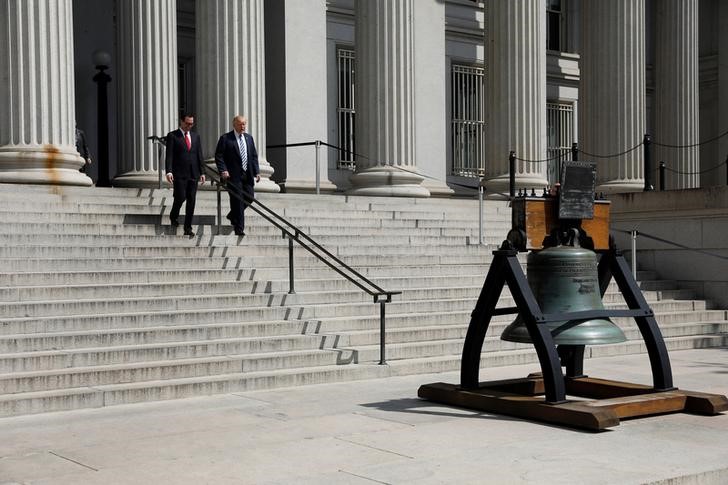 © Reuters. U.S. President Donald Trump departs after a signing ceremony with Treasury Secretary Steve Mnuchin at the Treasury Department in Washington
© Reuters. U.S. President Donald Trump departs after a signing ceremony with Treasury Secretary Steve Mnuchin at the Treasury Department in WashingtonBy Pete Schroeder
WASHINGTON (Reuters) – The U.S. Treasury Department has recommended preserving powers created after the 2007-2009 financial crisis that allow regulators to step in and wind down a failing bank, in a win for big banks and overseas regulators who had lobbied for the United States to keep it.
In a closely watched report published on Wednesday, the administration of Republican President Donald Trump favored keeping the “orderly liquidation authority” (OLA) created by the 2010 Dodd-Frank law but also urged Congress to expand the U.S. bankruptcy code to accommodate large financial institutions.
“Treasury recommends retaining OLA as an emergency tool for use under only extraordinary circumstances,” the report said.
“While bankruptcy must be the presumptive option, the bankruptcy of large, complex financial institutions may not be feasible in some circumstances,” the report said.
The Dodd-Frank OLA provision gives regulators special powers to wind down a complex financial institution in an orderly manner, including temporarily using taxpayer funds to provide emergency liquidity.
Regulators globally agreed special resolution powers were needed for large financial institutions after the 2008 collapse of investment bank Lehman Brothers, which highlighted that normal bankruptcy laws were not sophisticated enough for global banks.
The panic unleased by Lehman’s collapse led to a string of chaotic U.S. government-led bailouts that were reviled by the public and most politicians, prompting Congress to establish a formal policy for government intervention in future crises.
Trump ordered a review of the OLA in April as part of the administration’s broader pledge to review and roll back post-crisis regulations.
The Treasury’s recommendations will be met with a sigh of relief by large banks and regulators overseas who heavily lobbied the Treasury to protect the mechanism.
They warned that rescinding the OLA would increase systemic risk and make U.S. banks less safe in the eyes of overseas regulators who would potentially require them to ringfence more capital in the markets in which they operate.
Only Congress has the power to repeal the OLA, but Treasury’s opinion has loomed large in the debate.
The report will be welcomed by foreign governments, signaling that the United States is taking a measured approach to deregulation and is unwilling to tear up international standards.
But it is a blow for conservative Republicans in Congress who have pushed to repeal the Dodd-Frank powers which they say are a taxpayer bailout in disguise.
The OLA rules require all funds spent by the government to be recouped by fees on the banking industry, but conservatives say this temporary government lifeline is an improper intrusion into private markets.
The Treasury acknowledged the risks of rescinding the OLA, while noting it had “serious defects” that needed refining.
The report recommends reforming the OLA to limit its use, reduce the discretionary powers it affords bank regulators, and minimize the use of taxpayer funds to facilitate it.
Many of these proposals can be enacted by bank regulators, but enhancing the bankruptcy code can only be done by Congress. The Treasury’s endorsement of an expanded bankruptcy cody could inject new life into legislation currently pending before lawmakers.
Fusion Media or anyone involved with Fusion Media will not accept any liability for loss or damage as a result of reliance on the information including data, quotes, charts and buy/sell signals contained within this website. Please be fully informed regarding the risks and costs associated with trading the financial markets, it is one of the riskiest investment forms possible.
Source: Investing.com




























